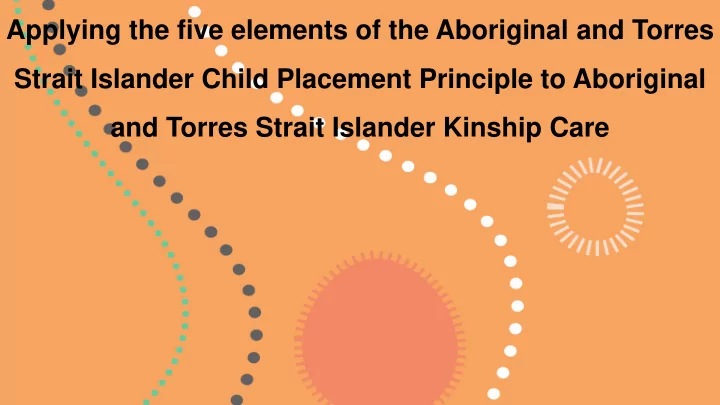

Applying the five elements of the Aboriginal and Torres Strait Islander Child Placement Principle to Aboriginal and Torres Strait Islander Kinship Care
Aboriginal and Torres Strait Islander kinship are diverse and complex systems. For the purpose of this presentation and QATSICPP Position paper, Aboriginal and Torres Strait Islander Kinship refers to the biological bloodlines that have been passed on from generation to generation. Consideration of who is kin to a child is also the decision and responsibility of family and those with cultural authority for the child.
Applying the five elements of the Aboriginal and Torres Strait Islander Child Placement Principle to Aboriginal and Torres Strait Islander Kinship Care
Prevention • Acknowledging that collective child rearing practices have operated for centuries • Aboriginal and Torres Strait Islander children have the right to be raised by Aboriginal and Torres Strait Islander kin connected to family, community, culture and country • Supported by Aboriginal and Torres Strait Islander community-controlled organisations (A&TSICCOs), • Aboriginal and Torres Strait Islander children and families have equitable access to quality services that are planned and delivered by A&TSICCOs.
Partnership • To prevent or limit contact with statutory child protection system, requires community members who are independent and external to the statutory child protection agency participating in decision making about protecting and caring for children • Properly resourced legislative role for community participation in all child protection decisions • A&TSICCOs facilitating FLDM processes for all families where child protection concerns are identified, particularly to identify kin by whom the child/ren can be raised
Placement • A child’s first placement by the statutory agency away from parents should be planned, made with the child and family’s participation, and involve community representatives, so that it is the right placement. The highest priority in the placement hierarchy. • If placement with relatives or extended family members is not possible at that time, kin should be identified and enabled so that the child/ren transition to their care to be raised in culture and community. • Reclaiming the definition of ‘kin’ to only include adults with a legitimate cultural connection to the child.
Participation • Families have the best knowledge about their caring strengths and risks. • Involving family in decision making • widens circles of support • identify placement options • take responsibility for plans to address safety concerns • Preventing or mitigating statutory involvement and where it occurs, acknowledging the child’s and family’s knowledge about their needs and how best to meet them. • Valuing the child’s views
Connection • Actively support children to maintain or establish their connections to family, community, culture and country. • Reunification with parents is supported early, with plans and culturally safe supports. • Options for reunification and reconnection are regularly reviewed, supported and progressed wherever possible.
Recommend
More recommend